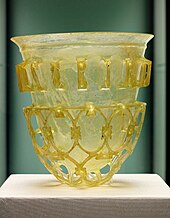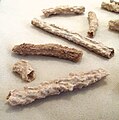Occurrence in nature

Glass can form naturally from volcanic magma. Obsidian is a common volcanic glass with high silica (SiO2) content formed when felsic lava extruded from a volcano cools rapidly. Impactite is a form of glass formed by the impact of a meteorite, where Moldavite (found in central and eastern Europe), and Libyan desert glass (found in areas in the eastern Sahara, the deserts of eastern Libya and western Egypt) are notable examples. Vitrification of quartz can also occur when lightning strikes sand, forming hollow, branching rootlike structures called fulgurites. Trinitite is a glassy residue formed from the desert floor sand at the Trinity nuclear bomb test site. Edeowie glass, found in South Australia, is proposed to originate from Pleistocene grassland fires, lightning strikes, or hypervelocity impact by one or several asteroids or comets.

A piece of volcanic obsidian glass

Moldavite, a natural glass formed by meteorite impact, from Besednice, Bohemia

Tube fulgurites

Trinitite, a glass made by the Trinity nuclear-weapon test

Libyan desert glass





Comments
Post a Comment